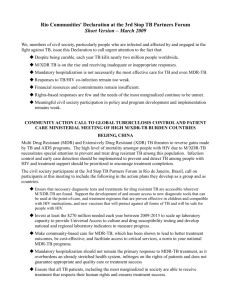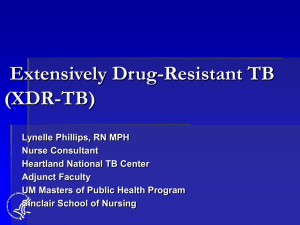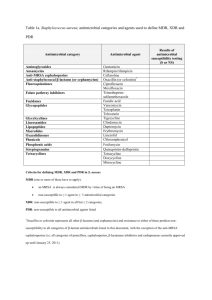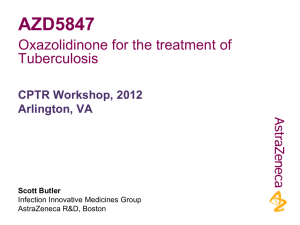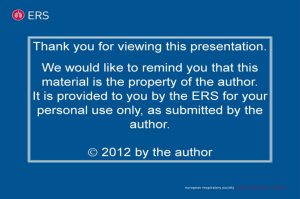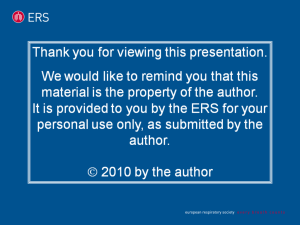3. Extensively Drug Resistant TB (XDR-TB)
advertisement
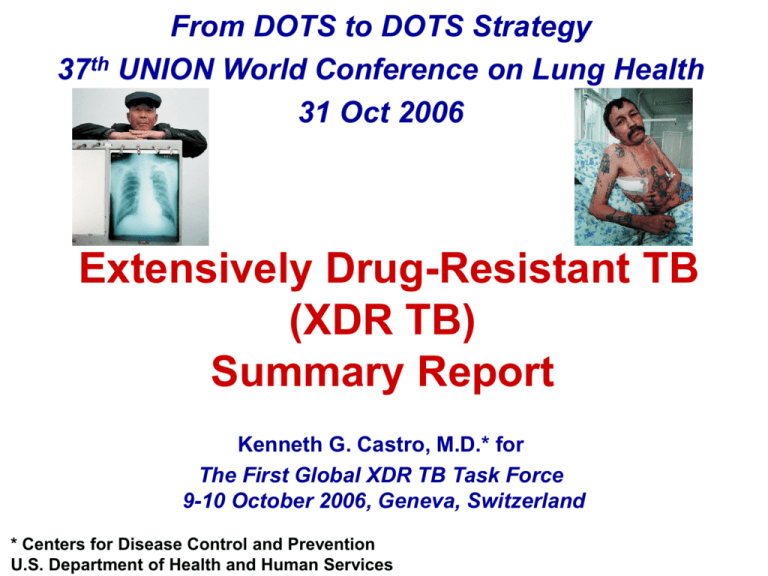
From DOTS to DOTS Strategy 37th UNION World Conference on Lung Health 31 Oct 2006 Extensively Drug-Resistant TB (XDR TB) Summary Report Kenneth G. Castro, M.D.* for The First Global XDR TB Task Force 9-10 October 2006, Geneva, Switzerland * Centers for Disease Control and Prevention U.S. Department of Health and Human Services Global WHO/IUATLD/CDC Survey • Prompted by anecdotal descriptions of virtually untreatable TB patients • Mycobacterium tuberculosis isolates with multidrug resistance (MDR) and more extensive drug resitance patterns Second-Line Drug Classes for MDR TB Treatment Aminoglycosides Polypeptides First line drugs Fluoroquinolones Amikacin, Kanamycin Capreomycin Ciprofloxacin, Ofloxacin + Thioamides Serine analogues Ethionamide, Prothionamide Cycloserine PAS WHO. Guidelines for the programmatic management of drug-resistant tuberculosis. 2006. Global WHO/IUATLD/CDC Survey • Convenience sample (17,690 isolates) submitted to participating international SRL network, 2000-2004 – 3520 (20%) of isolates MDR TB – 347 ( 2%) of isolates XDR TB • XDRTB in all regions, more common FSU and Asia (Republic of Korea) • Denominator information unavailable Number of MDR and XDR Cases, by Countries Submitting ≥ 1 M. tuberculosis Isolate to Participating SRLs, 2000–2004 Ind. Nations MDR 821 XDR 53 (6%) Latin America MDR 543 XDR 32 (6%) E. Europe MDR 406 XDR 55 (14%) Rep. Korea MDR 1298 XDR 200 (15%) Asia MDR 274 XDR 4 (1%) Africa, Middle East Isolates contributed to survey MDR 156 XDR 1 (< 1%) Total MDR= 3520; XDR= 347 (~ 10% of MDR) KZN Hospital Background* • 119 patients in TB/ARV integration study – 14 deaths – 10 (71%) of 14 with MDRTB – 6/10 MDRTB resistant to all tested first and second line drugs (SLD) for TB • INH, RIF, EMB, STR, KANA, CIPRO • Suggestive of probable extensive drug resistant TB in this hospital • Prompted survey Jan 2005-Mar 2006 * Moll A, Gandhi NR, Pawinski R, Lalloo U, Sturm AW, Zeller K, Andrews J, Friedland G. HIV associated Extensively Drug-Resistant TB (XDR-TB) in Rural KwaZulu-Natal (South Africa MRC Expert Consultation Sept 8, 2006) KZN Drug Resistant TB Survey* 1539 isolates tested 544 (35%) Cx+ M. tuberculosis 221(41%) MDRTB 995 (65%) Cx Negative 323 (59%) Susceptible 53 (10%) XDRTB (24% of MDRTB) * Moll A, Gandhi NR, Pawinski R, Lalloo U, Sturm AW, Zeller K, Andrews J, Friedland G. HIV associated Extensively Drug-Resistant TB (XDR-TB) in Rural KwaZulu-Natal (South Africa MRC Expert Consultation Sept 8, 2006) KZN XDRTB Survey Patient Characteristics* Characteristics • No prior TB Treatment • Prior TB treatment – Cure or Completed treatment – Treatment Default or Failure • HIV-infected (44 tested) • Dead (Includes 34% on ARV) • Identical M. tb spoligotype No. (%) 26 (51) 14 (28) 7 (14) 44 (100) 52 (98) 26/30 * Moll A, Gandhi NR, Pawinski R, Lalloo U, Sturm AW, Zeller K, Andrews J, Friedland G. HIV associated Extensively Drug-Resistant TB (XDR-TB) in Rural KwaZulu-Natal (South Africa MRC Expert Consultation Sept 8, 2006) Global 7-point Action Plan to Combat XDR TB Emphasizes Essentials of Proper TB Control 1. 2. 3. 4. 5. 6. 7. Conduct rapid surveys of XDR TB (determine burden) Enhance laboratory capacity (emphasis on rapid DST) Improve technical capacity of clinical and public health practitioners to effectively respond to XDR TB outbreaks and manage patients Implement infection control precautions (PLHA focus) Increase research support for anti-TB drug development Increase research support for rapid diagnostic test development Promote universal access to ARVs under joint TB/HIV activities MRC Consultation, Johannesburg, South Africa. Sept 7, 2006 First Global XDR TBTask Force 9-10 October 2006 Meeting Objectives • Define key issues, make recommendations and identify urgent action steps required in next 3-6 months: - Management of XDR TB suspects in high and low HIV settings - Programmatic management of XDR TB treatment and Rx design - Laboratory XDR TB definitions - Infection control and protection of health care workers, with emphasis on high HIV settings - Immediate XDR TB surveillance activities and needs - Advocacy, communication, social mobilization strategies • Develop plans for appropriate global response, and within countries, including designation of roles and responsibilities Revised WHO Case Definition for XDR TB (9 Oct 2006) Goals • Public health surveillance • Reliable DST methodology • Clinical relevance • Relatively simple Resistance to at least isoniazid and rifampin (MDR) plus resistance to fluoroquinolones and one of the second-line injectable drugs (amikacin, kanamycin, or capreomycin) TB Treatment Outcomes, by Selected Drug Resistance Patterns, Latvia, 2000-2003* Cure Completion Death Default Failed Continue Tx HIV+ HR+AG+FQ HR+INJ+FQ HR+3SLD MDR-TB All 0 10 20 30 40 50 60 Percent * Leimane V, et al. First Global XDR TB Task Force Meeting. Oct 9, 2006 (from N = 820 evaluated) 70 Identified Needs • Coordination and collaboration – Content – International partners – Countries • Resource mobilization • Crude costs Content for Collaboration • Dissemination of the revised XDR TB definition • TB diagnostic and laboratory strengthening • Management principles for suspected cases of XDR TB and MDR TB • Programmatic management of MDR and XDR TB within basic TB and health systems • Infection control, HCW and patient protection • Surveillance principles and protocols • Related operational research, and R&D • Advocacy, communications and social mobilization strategies Available Assistance from Partners • International training for countries and consultants – WHO: Latvia and regional; CDC and IUATLD – HIV/AIDS Treat, Train, and Retain partners • GFATM reprogramming and Round 7 applications (WHO and partners) • PEPFAR consideration of inclusion of XDR TB in 2007 country operational plans (COPs) (USG) • TBCAP (USAID) • GLC (GLC members/secretariat/consultants) • Drug resistance surveillance and SRL link (WHO/THD) • Prequalification of manufacturers (EDM) • All 7 Stop TB WGs, sub-groups and partners • TB and HIV/AIDS civil society partners • Potential for other donor engagement (e.g., bilaterals, UNAIDS, World Bank, UNITAID, OSI, B&M Gates Foundation, EU, others) Country Coordination • Country-by-country response to requests for technical assistance in all heavily-affected countries • Meeting of Department of Health, South Africa, and WHO with 14 SADC countries to develop country plans for TA needed to respond to MDR TB/XDR TB – – – – – – – Basic TB control (5 pillars of DOTS) and HIV/AIDS care Clinical management Laboratory capacity and use of new methods Drug registration, procurement, quality and logistics Infection control Surveillance of MDR-TB, XDR-TB, and research Advocacy, communications and social mobilization • Linkage of Estonia, Latvia, Peru, Philippines with countries in need Country XDR TB Response Matrix Country: Area Basic TB control Clinical management M,XDR-TB Laboratory capacity 2L Drug management Infection control Surveillance/ OR Advocacy, communications Social mobilization Key technical partner: Current status Key activities required Responsible organisation (MoH, NGO etc) Budget Source of Funds Research and Development • Meeting in next 2-3 months, WHO, Stop TB Partnership R&D working groups and IUATLD Paris (Nov 2006) • Critical importance of access to currently available rapid rifampicin tests in highly-affected countries • Related drug registration issues Comparison GenoType® MTBDR and INNO-LiPA Rif.TB GenoType® MTBDR INNO-LiPA Rif.TB Hain Lifescience Innogenetics M. tuberculosis detection Yes Yes Detection of RMP Resistance in M. tb Complex Yes Yes Detection INH Resistance in M. tb Complex Yes No Strip Assay Yes Yes DNA-Basis: PCR Yes Yes Culture requested Yes Yes Direct assay No Yes (modified version) M. tub-Komplex Detection: 23S-rRNA/16S-rRNA Yes Yes RMP-Resistance: rpoB gene Yes Yes INH-Resistance: katG gene Yes No Universalcontrol Yes No rpoB unicontrol Yes No kat G unicontrol Yes No Company TB Clinical Development Pipeline Compound Development Stage Sponsor / Coordinator Phase III EC / OFLOTUB Consortium; IRD*; WHO TDR; Lupin Ltd. Moxifloxacin Phase II / III Bayer; TB Alliance; CDC; University College of London; Johns Hopkins University TMC 207 Early Bactericidal Activity Johnson & Johnson (Tibotec) OPC-67683 Early Bactericidal Activity Otsuka Pharmaceutical Co., Ltd. PA-824 Phase I TB Alliance LL-3858 Phase I Lupin Ltd. Gatifloxacin Novel compounds, highlighted in blue italics, are active against MDR/XDR TB * Institut de Recherche pour le Developement World Health Organization, Tropical Disease Research for Disease Control and Prevention Centers Laboratory Capacity Building • Urgent need for enlarged budgeted plan for lab capacity building (hardware, software, personnel, policy guidance, training, technical assistance, and resource mobilization) – Needs to address basic capacity as well as MDR and XDR-specific concerns – Ensure improved coordination across technical and financial partners and others engaged in laboratory networks beyond TB • Strong public statement on lab strengthening as prerequisite for XDR TB response Next Steps 1. WHO and partners further develop costedplans with estimated needs and gaps (within 3 weeks) - Take into consideration action proposed by breakout groups - Immediate needs for country assessment support, short-term and medium-term needs (on thematic areas presented above) 2. Briefings of potential financing and technical partners not present to share meeting results, and discuss areas of interest for technical and/or financial collaboration 3. Prepare specific proposals 4. Review Global Plan and adjustments needed Global Coordination • Stop TB Partnership Coordinating Board (Indonesia, Nov, 2006) – Scale up TB control in Africa and Eastern Europe • Review approach to laboratory strengthening, drug resistance scale-up and inclusion of infection control in the Global Plan, 2006-2015 • Review and revise links between MDR TB working group and all 6 other working groups and relevant sub-groups (e.g., designation of liaison on XDR TB response in each WG?) Acknowledgements • KZN Investigators – A Moll, NR Gandhi, R Pawinski, U Lalloo, AW Sturm, K Zeller, J Andrews, G Friedland • SADC Countries • First Global XDR Task Force Participants – http://www.who.int/mediacentre/news/notes/2006/np29/en/index.html • • • • • SA MRC, WHO Stop TB, CDC SRLs TAG FIND Global Alliance for TB Drugs WHO GLOBAL TASK FORCE ON XDR-TB, OCTOBER 2006 - OUTCOMES AND RECOMMENDATIONS • Preventing XDR-TB through strengthening TB and HIV control To prevent the appearance and spread of drug-resistant TB, the Task Force underlined as a priority the need for the immediate strengthening of TB control in countries, as detailed in the new Stop TB Strategy and Global Plan to Stop TB 2006-2015. This should be done in coordination with scaling up universal access to HIV treatment and care. WHO and Task Force members will help mobilize teams of experts that can be deployed in the field, at the request of countries, to assist in strengthening TB control, and where relevant HIV control. There were also specific recommendations on: • Management of XDR-TB suspects in high and low HIV prevalence settings: Accelerate access to rapid tests for rifampicin resistance, to improve case detection of all patients suspected of multidrugresistant TB (MDR-TB) so that they can be given treatment that is as effective as possible. Rapid diagnosis is potentially life saving to those who are HIV positive. • Programme management of XDR-TB and treatment design in HIV negative and positive people: – Adhere to WHO Guidelines for the Programmatic Management of Drug Resistant TB; – Improve MDR-TB management conditions; – Enable access to all MDR-TB second-line drugs, under proper conditions; – Ensure all patients with HIV are adequately treated for TB and started on appropriate antiretroviral therapy. • Laboratory XDR-TB definition: XDR-TB is defined as resistance to at least rifampicin and isoniazid from among the first line anti-TB drugs (which is the definition of MDR-TB) in addition to resistance to any fluoroquinolone, and to at least one of three injectable second-line anti-TB drugs used in TB treatment (capreomycin, kanamicin, and amikacin). • Infection control and protection of health care workers with emphasis on high HIV prevalence settings: Accelerate wide implementation of recommended infection control measures in health care settings and other risk areas in order to reduce the ongoing transmission of drug-resistant TB, especially among those who are HIV positive. • Immediate XDR-TB surveillance activities and needs: Strengthen laboratory capacity to diagnose, manage and survey drug resistance; Commence rapid surveys of drugresistant TB so that the extent and size of the XDR-TB epidemic, and its association with HIV, can be determined. • Advocacy, communication and social mobilization: • Initiate information-sharing strategies that promote effective prevention, treatment, control of XDR-TB at global and national levels and also in high HIV prevalence settings; • Strengthen communication with affected communities and individuals; • Develop a fully-budgeted plan with the resources and funding required to address XDR-TB, including through necessary improvements in overall TB control and HIV care in the immediate and medium term; • Initiate resource mobilization. • Planning is also underway for a focused meeting in the near future on research and development issues relating to TB, including promoting the development of the new diagnostics, drugs and vaccines that are urgently needed. A meeting on antiretroviral therapy and XDR-TB is also planned.
